A self-study, self-paced course where you can learn how to paint in watercolor by watching video lessons and doing assignments
$297 USD
ENROLL NOWA self-study, self-paced course where you can learn how to paint in watercolor by watching video lessons and doing assignments
$297 USD
ENROLL NOWOne-to-one, unlimited and custom-tailored to your skills and needs Personal Tutoring by the Watercolor Academy teachers
$997 USD
ENROLL NOWVideo lesson by Vladimir London
In this video lesson, you will learn about the art materials needed for the Watercolor Academy course.
In order of importance, necessary watercolor materials include:
Before we begin with art supplies, I have to make a disclaimer. The advice given in this video is based on our experiences, personal preferences, extensive research, and common sense. We do not advocate for the use of any particular brands or manufacturers.
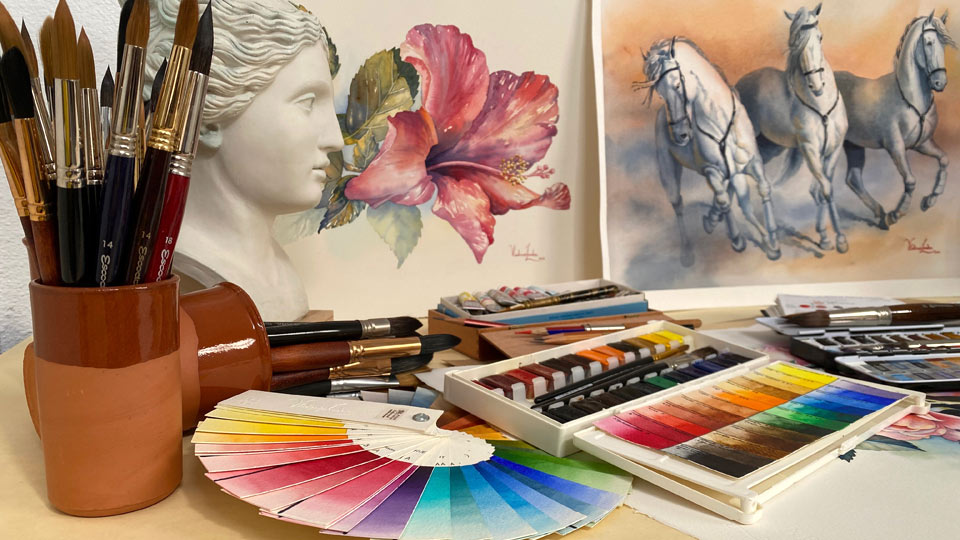
I put paper above the rest of the art supplies for good reason. With watercolor, it not only offers support but is also a part of the artwork. Watercolor paper should be white and sturdy, take water and paint well, and withstand extensive mechanical abrasion by brushes and sponges.
So, which paper should you buy? The choice should depend on your preference, working habits, and painting style.
If you have no preferences nor knowledge of watercolor paper, here's the general advice. Go for 100% cotton paper that comes from a reputable brand. It must be acid-free, have a weight of 140lb (300gsm), and a cold-pressed, mid-size tooth surface. In terms of price, paper rolls cost less per square meter, followed by loose sheets. Blocks, pads, and sketchbooks are more expensive. You may want to buy the full sheet and cut it into smaller sizes.
Do not be tempted to save on paper. Good paper is expensive, but you will spend more on cheap paper because you will waste it; you can't do a high-quality artwork on it. Experiment with different paper brands and types. Eventually, you will find one that suits your style. With time, your style will evolve, and so might your paper choices.
If you already have some experience and need more information about watercolor paper, here it is.
The key characteristics of watercolor paper are:
Watercolor paper is made in one of the following ways:
Handmade and mold-made paper tend to be more durable and distort less under heavy washes, but they are considerably more expensive.
Paper is made of cellulose fibers, which are historically prepared from cotton or linen.
Five-hundred-year-old drawings remain in better condition today than artworks from the eighteenth and nineteenth centuries. This is because paper manufacturers improved their profit margins by adding wood pulp, clays, and other fillers to dilute the mixture, and added chemicals and acids to make the paper whiter.
The composition of the paper determines its durability. Aim for 100% cotton paper. Some manufactures make "rag paper," claiming it is cotton. Rags often contain synthetic fibers; such paper may be up to 80% non-cotton fillers and wood. Pure cotton paper is strong and pliable. It will take paints well and resist mechanical damage from scraping, taping, masking, and rubbing.
The best quality watercolor paper meets the following criteria:
The weight of paper indicates how heavy, and therefore thick, it is. It does not indicate paper quality.
In the Imperial system, the weight of paper is measured in pounds per 500 sheets (one ream), and in the metric system, by grams per square meter (gsm).
Medium paper weight 300gsm (140lb) offers a better value for your money. The alternatives are cheaper, light-weight papers (80lb) that curl and buckle when wet and have to be stretched, or heavy-weight papers 600gsm (280lb) that are stiff like a board but twice as expensive.
There are three types of surface textures:
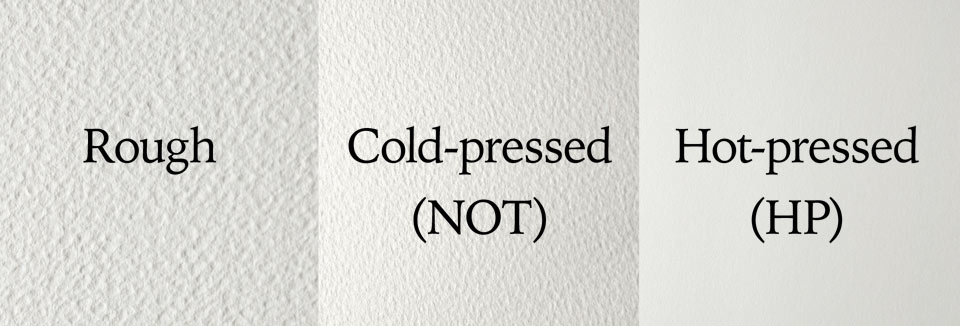
As its name suggests, a rough surface comes with a prominent tooth (texture). Hot-pressed is smooth, hard, and fine. Cold-pressed is somewhere in between the two.
Rough paper is better suited for impressionistic styles and loose brushstrokes. Its surface absorbs water very well.
Hot-pressed paper is suitable for fine-detail artworks, but not for big washes.
Cold-pressed paper is acceptable for smaller details and smooth washes. The medium-grained texture is easier to paint on and more versatile than the others.
In general, whiter watercolor paper is best. Because watercolor artwork does not use white pigments, the natural tint of the paper will be your lightest tone. Some papers are lighter than others. You should also consider how the paper was bleached. Natural bleaching is preferred to chemicals and acids.
Historically, watercolor paper sizing was based on the Imperial system, which was standardized in 1836. Here are the various sizes that you may encounter in old literature, although contemporary paper manufacturers may no longer use this terminology:
Metric paper sizing is built around the square-root-of-two ratio. The largest size, A0, has an area of 1 square meter. Each smaller size is half of the one before it. The width of the larger sheet becomes the length of the smaller sheet. For example, two A3 sheets side-by-side are equal to one sheet of A2 paper.
Watercolor paper is sold in individual sheets, rolls, blocks, pads, and sketchbooks.
The best quality watercolor paper is handmade and available in individual sheets. Sizes are often not standard and there is a genuine deckle edge on all four sides. The deckle is a thinned stripe of cellulose that is left un-trimmed as an indication of a non-machine manufacturing process.
The mold-made papers sold in sheets might have two genuine deckle edges and two fake ones along the sides that were cut from the roll.
You will find more information about watercolor papers, including how to test their quality, in my "Book on Watercolor."
Good tools are essential for watercolor painting. So, go for the best paintbrushes you can find, especially because you don't need many of them. A high-quality brush will last for years if you take good care of it.
Here's what to look for in a watercolor paintbrush.
The brush handle must feel comfortable in your hand.
The ferrule has to be seamless. Look for a cylinder that is plated or made of copper alloys to avoid corrosion. A good grip is essential.
The most important part of the brush is the bristles, which can be made of natural hair, synthetic fibers, or a combination of both.
When it comes to natural hair, a genuine Kolinsky sable brush is the best. Its hairs have a very sharp, pointed tip and are tapered at both ends. This creates a belly between the base and the tip. Such brushes have a high paint capacity and natural spring; they are durable and resilient. These qualities are unmatched. The rarity of the species, difficult hunting conditions, and incredible quality justify the high prices. Here's the Siberian Kolinsky brush, size 50. It costs a whopping $1,700. Of course, I do not advocate going at such an extreme. Smaller, more affordable brushes are widely available.
A cheaper alternative to Kolinsky sable hair is the natural red sable. Red sable hairs are slightly thinner, stiffer, and shorter, but almost as thirsty and resilient as kolinsky sable hairs.
You should also consider squirrel hair. Squirrel brushes are very soft and absorbent; they can hold and release more water or paint than sable brushes and have a very pointing tip when wet. Because squirrel hairs are soft, the brushes don't have the same spring as sable hair ones.
If price, availability, or ethical concerns are an issue, consider synthetic brushes. High-quality synthetic fibers come very close to natural hair, but they come at a fraction of the cost.
You will need both round and flat brushes.
Round brushes can be divided into three categories:
Flat brushes have a square or rectangular shape with a straight edge, and can be categorized as follows:
There are also other specialty brushes with different shapes and sizes that are optional, depending on your needs and painting style.
Mop brushes are round, made of soft hairs (usually squirrel), very thirsty, and have a pointed tip when wet. Mops are good for both thin and wide lines and washes.
Wash brushes are wide and flat, ranging from 1" to 4", and ideal for wetting paper or applying wide washes over big areas. There are many more types of watercolor brushes. The good news is that you don't need a lot of them.
Here's a short list of brush shapes and sizes to start with:
1. Round (natural or synthetic sable):
2. Round (natural or synthetic squirrel):
3. Mop (natural or synthetic squirrel):
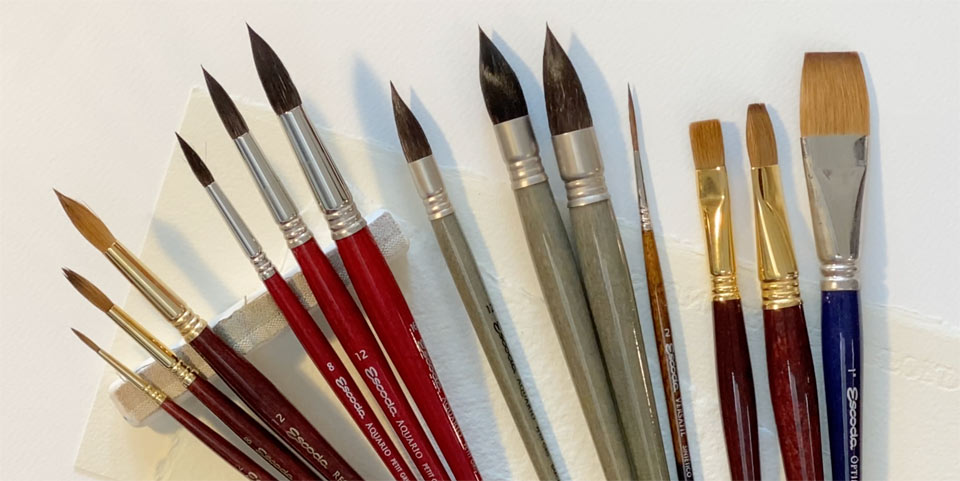
You can add some other shapes to your brush set as your painting skills develop.
The size of your brushes depends on your painting techniques and the size of the artwork. A good rule is to go always for a bigger size than you think you need.
A good brush will display the following characteristics:
In my "Book on Watercolor," I described in detail how to test these qualities.
If you buy a new brush, it will likely be covered in starch or gum arabic coating to prevent any physical damage to the bristles. Do not soften the coating with your fingers while it is dry. Instead, wet the tip in moderately warm water. After several minutes of rinsing, work the bristles very gently with clean fingers and rinse thoroughly to get rid of any remaining residue.
Good brushes are expensive, so you have to handle them with care. Here are a few simple tips and tricks for handling your brushes.
1. Wash your brushes after each painting session. Usually, rinsing the tip for a few minutes under moderately warm running water does the job. Soap is not required.
2. Do not keep a brush standing in water on its tip, even for a short time. This will ruin the brush.
3. Do not dip or rinse a brush in water deeper than its ferrule. No water should come in contact with the wooden handle. The same rule applies to plastic-handled brushes to prevent any moisture coming inside the ferrule.
4. Do not use expensive brushes to dilute dried pan paints. Instead, use stiffer and cheaper brushes for the preparation of paints and save your expensive brushes for painting.
5. Do not pull the hair with your fingers, blotting paper, or a towel. Squeeze the tip gently, instead.
6. Do not cut the tip with scissors or a knife to "improve" its shape.
7. Do not use watercolor brushes for any other mediums, especially not oil or acrylic. This will immediately make them unsuitable for watercolor painting.
8. Do not use good watercolor brushes to apply masking fluids. This is will instantly ruin your brushes.
9. Dry your brushes horizontally. Place them tilted with the tip down. Do not put them vertically in a mug or container with the tip facing up. Doing so traps water in the ferrule.
10. Round brushes are usually sold with plastic protective cylinders. Hold on to these and put them back on your brushes in between uses. Keep in mind that the brush must be fully dry before placing a plastic protector on it.
11. Do not use bamboo wrappers to store and transport brushes, as hair can get trapped between the bamboo sticks. Use cotton wrappers to avoid damaging your brushes.
12. Airtight plastic containers (like those for spaghetti) are very good to protect brushes from physical damage, high humidity, and insects. Do not place wet or damp brushes into such containers to prevent forming a mold.
I often receive questions like "what are the best watercolor paints?" As with paper and brushes, it depends on your painting style and artistic needs.
First, let's clarify the terminology that is so often misused. Paints, colors, dyes, and pigments are all very different things. Color is a physical characteristic of reflected light. The color of paint comes from either pigments or dyes. Pigments are microscopic particles that do not dissolve in water; they are suspended in the paint mixture. Dyes are completely soluble and bind directly with the support (paper). Paint is a mixture of pigments or dyes with the vehicle.
There are hundreds and hundreds of paints on the market; many have similar names for different colors, similar colors with different names, brand-proprietary names, and various "poetic" names. To clarify the situation, we need to talk about pigments, not colors.
Watercolor paints are pigments mixed with a paint vehicle. The paint vehicle keeps pigment particles suspended and binds them to paper. It can make up more than 90% of a paint's volume. A larger ratio of pigment to paint vehicle indicates higher quality, but a higher price, as well.
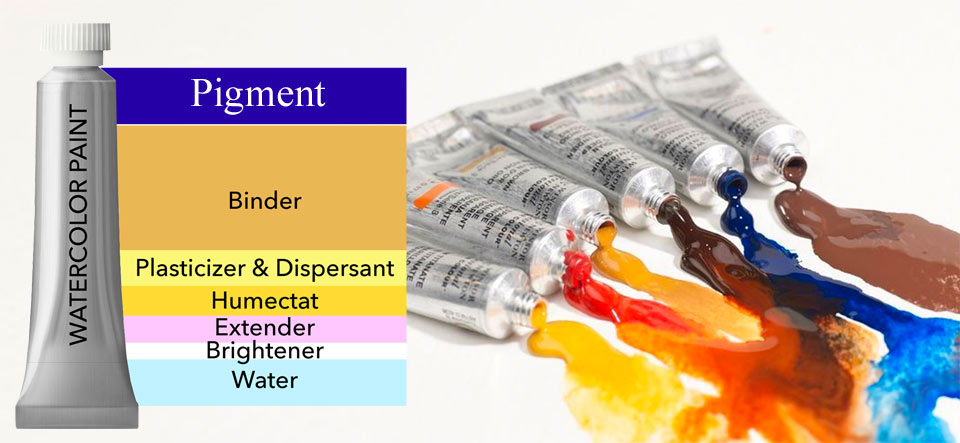
Another important characteristic of paints is lightfastness, which is its resistance to damage from natural light.
The tinting strength of a pigment (or its colorant power) determines how much of the pigment is needed to produce the required color intensity. It also defines how much the pigment will dominate in a mixture with other pigments.
Staining power describes a certain pigment's resistance to lifting. This quality makes watercolor painting "non-forgiving," as some paint strokes can be difficult to correct with diluting, whipping, or bloating.
Another essential quality is transparency, which is opposite to hiding power; higher transparency leads to lower hiding power. A paint's transparency is usually labeled as shaded, half-shaded, crossed, or empty square, indicating fully-opaque, semi-opaque, semi-transparent, and transparent paints, respectively.
If you are a complete beginner and need guidance, here are three criteria to keep in mind when shopping for watercolor paints:
If you do not have any watercolor paints and are wondering what to buy, here's the list to consider. Do not take it as a direct suggestion, because your painting style, and therefore choice of paints, might be very different from mine:
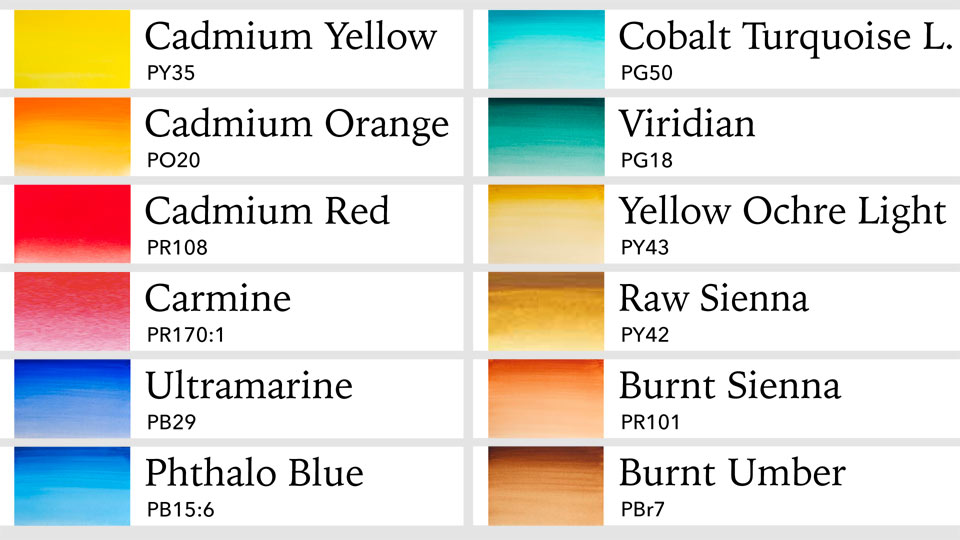
Alternatively, you may get a 12 or 24-paint box from a reputable brand with pre-selected colors.
When painting with watercolors, you do not need white or black pigments, even though they are available on the market. White in watercolor comes from the color of paper and black always looks better when mixed from complementary pigments.
With time, you can expand your collection of pigments as you test new paints and discard others.
You should arrange your box of paints however you see fit. You can place paints according to the color wheel—yellow, orange, red, violet, blue, and green,—by placing different colors within the same hue by their temperature. You can also separate the earth pigments from the rest.I recommend that you create labels for your paints, keeping swatches next to the pans in your box. This way, you will learn the different paint names faster and have easy access to information like permanence, pigment code, lightfastness, and opacity.
Keep a reference list of all the paints you use, including their properties. You can use this to make and update a collection of watercolor swatches. On each swatch, make a note of the manufacturer, paint name, pigment code, permanence, lightfastness, and opacity. Apply a gradient of paint from full opacity to a light tint on top of a black line made with a permanent marker. This will show you not only the color but the opacity, as well.
To learn more about the lightfastness of your paints, you can do a test by placing swatches in direct sunlight for three or even six months. Part of the diagram has to be hidden from light and another half exposed. I did a couple of tests, one for a Russian manufacturer and another with Windsor & Newton paints. This test revealed that some colors were affected by natural light, which helped me to fine-tune my collection of paints.
There is much more information about watercolor paints, including how to test their qualities, in my "Book on Watercolor".
There are some miscellaneous materials that you will need to set up your workspace. I've listed them here in no particular order.
You must have a water bucket. Although any water-holding container would do, ideally, you need a big glass jar that holds more than two liters (half a gallon) of water. In a glass jar, it is easier to see how dirty the water is and change it accordingly. A large container is much more convenient because the water lasts longer.
In the studio, when the space permits, I use not one but two water buckets—one for washing dirty brushes and another with clean water for mixing paints.
When painting outdoors, a plastic container is a better choice than a heavy, fragile glass one.
A mixing palette is another must-have item.
Because a professional watercolor artist spends as much time preparing paints as they do painting, a good palette is essential. It should be white and durable.
Some watercolor boxes have a palette built-in. This is handy for outdoor painting, but not sufficient for painting in the studio.
For working in the studio, I recommend using multiple large palettes made of porcelain. Usually, they come with partitions to separate paints that come in a tube. A white porcelain plate and a butcher's tray can be cheaper alternatives.
Unlike a white plastic palette, porcelain won't be stained by dye paints and is easy to wash. It is a personal preference whether to wash palettes or not. Some artists choose to not wash their palettes; this is a personal preference.
White porcelain saucers or coffee cups can also be used to prepare large amounts of paint. Keep a few on hand.
Get some paper towels or blotting paper to absorb the excess water or paint from your paper and brushes. Some artists use a clean cotton towel to absorb water from paper and a separate one for wiping brushes.
Another item you may find very handy is a sponge. You can use it to wet paper, absorb water from paper and brushes, and apply paints. Natural sea sponges are more expensive than synthetic ones, but they have an organic pattern that can be used for painting.
Purchase some pencils and erasers to make preliminary sketches, drawings, and under-drawings.
You will also need a roll of two-inch-wide masking tape. All other materials and mediums for watercolor painting are optional.
A self-study, self-paced course where you can learn how to paint in watercolor by watching video lessons and doing assignments
One-time payment - Lifetime membership
$297 USD
One-to-one, unlimited and custom-tailored to your skills and needs Personal Tutoring by the Watercolor Academy teachers
One-time payment - Lifetime membership
$997 USD